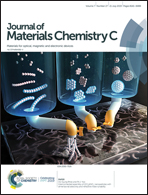Visible to near-infrared persistent luminescence from Tm3+-doped two-dimensional layered perovskite Sr2SnO4
Abstract
Persistent luminescent (PPL) materials have attracted wide attention in various fields, such as bio-imaging, optical information memory, and emergency lighting and signs. Single ion doped PPL materials with stable emission are ideal for practical applications, but a PPL material that covers the entire wavelength range, from visible to near infrared, is difficult to achieve in a single-ion doped material. Here, we present a novel PPL phosphor whose emission ranges from 440 to 850 nm, from a single Tm3+ ion doped Sr2SnO4. Persistent bluish-green light from the optimally alloyed sample (Sr1.98SnO4:0.02Tm3+) can be observed by the naked eye after 30 min, which may be due to the interactions between electron traps from Tm3+ doping and the host deeper than 0.71 eV, as indicated by thermoluminescence (TL) analysis. The fabricated intelligent PPL, using two-dimensional code technology with a write-in and read-out property, was achieved, while the performance of NIR PPL needs to be improved in the future. We anticipate that these results will stimulate research on single emitter-based PPL emission phosphors and diodes for next-generation lighting and anticounterfeiting technology.



 Please wait while we load your content...
Please wait while we load your content...